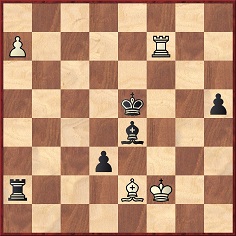
Edward Winter
How many commonplace terms in chess play were created in the twentieth century? One prominent example is ‘skewer’, an invention in the late 1930s by Edgar Pennell, then a teacher at Salisbury Road School, Liverpool.
Under the heading ‘A New Chess Term’ CHESS, 14 February 1939 (page 212) reported:
‘Mr Pennell’s teaching is original in the extreme. Bystanders at Blackpool [i.e. at the British Chess Federation Congress in 1937] wondered at the strange terms such as “skewer” with which the boys interlarded their conversation. Explanations revealed that it was a term coined by Mr Pennell …
It seems only just that English should contribute its bit to the nomenclature of chess and we hope Mr Pennell’s name will be associated in perpetuity with this useful addition to the chessplayer’s vocabulary.
Tailpiece: Mr Pennell is a rotten player himself, as he makes haste to admit. His own pupils beat him.’
As an example of the skewer we pick a position from page 363 of the December 1910 Deutsche Schachzeitung. The only information provided about the occasion was that the game had occurred recently in the Wellington Chess Club in New Zealand and that White’s name was Barnes.

White drew with 1 Re7+ Kd4 2 Rxe4+ Kxe4 3 a8(Q)+ Rxa8 4 Bf3+.
(3061)
This position comes from page 26 of Alexander on Chess by C.H.O’D. Alexander (London, 1974):
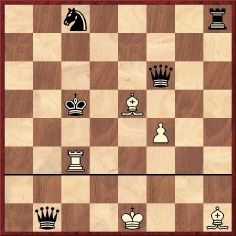
Alexander’s caption reads:
‘Three examples of the skewer. White bishop skewers R through the Q and the White rook skewers Kt through the K; Black Q skewers B through K at bottom of diagram.’
The term ‘skewer’ is absent from the Small Chess Dictionary by Y. Averbakh (Belgrade, 1980), and translations into various languages will therefore be welcomed. In German, for example, Spiess is the rough equivalent, although it has no entry in German-language chess encyclopaedias and dictionaries. As regards Spanish, page 21 of Enciclopedia del ajedrez by H. Golombek (Barcelona, 1980) translated skewer by ataque ‘a través’ .
Another term for skewer in English (particularly in the United States) is x-ray attack. When did that make its first appearance in chess literature?
(4231)
Turning to the French term for skewer, Hassan Roger Sadeghi (Lausanne, Switzerland) quotes the definition of ‘enfilade’ on page 31 of Le guide des échecs by N. Giffard and A. Biénabe (Paris, 1993):
‘Attaque, avec une pièce à longue portée, d’une pièce adverse derrière laquelle se situe, sur la même ligne d’action, une autre pièce du camp opposé. Si la première fuit, la deuxième se fait prendre. C’est tout l’intérêt de cette attaque.’
The entry for ‘enfilade’ on pages 131-132 of the Dictionnaire des échecs by F. Le Lionnais and E. Maget (Paris, 1967) limited itself to cases where check is given, commenting that ‘certaines études artistiques sont fondées sur les échecs enfilade’. The example presented by the Dictionnaire was a study by Henri Rinck from page 217 of the July 1903 Deutsche Schachzeitung:
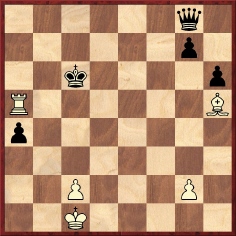
‘1 Ra8 If 1...Qxa8 2 Bf3+ enfilade; if 1...Qh7 2 Bg6 Qxg6 3 Ra6+ enfilade; if 1...Qc4 2 Rc8+ enfilade; if 1...Qa2 2 Rxa4 and if 2...Qxa4 3 Be8+ enfilade, etc.’
The solution as given on page 299 of the October 1903 Deutsche Schachzeitung was 1 Ra8 Qa2 2 Rxa4 Qg8 3 Ra8 Qh7 4 Bg6 and wins. The Dictionnaire added a white pawn on a2, but that square was empty not only in the German magazine but also when Rinck gave the study in his books, e.g. on pages 254-255 of 300 fins de partie (Barcelona, 1919). Below is the title page of our copy, inscribed by Rinck:
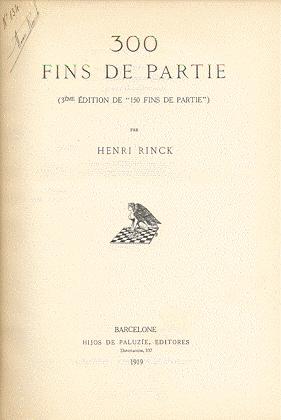
(4235)
Pages 65-66 of the Diccionario de ajedrez by A. Gude (Madrid, 2005) use the term ‘enfilada’, adding that it is also known in Spanish as ‘ataque en línea’.
(4236)
C.N. 4231 asked when ‘x-ray attack’ first appeared in chess literature. Jack O’Keefe (Ann Arbor, MI, USA) writes:
‘The term “x-ray attack” was apparently originated by Kenneth Harkness. On page 25 of the April 1947 Chess Review, in his series “Picture Guide to Chess”, he mentioned forks and then wrote:
“There is another type of double attack in which the targets are threatened in one direction. The attacking piece threatens two units, one behind the other, on the same rank, file or diagonal. This double threat has lacked a good descriptive name. We suggest ‘X-Ray’ attack.”’
The article by Harkness (pages 25-30) gave many illustrative positions and used the term x-ray countless times.
(4245)
Christian Sánchez (Rosario, Argentina) notes that for the skewer motif Milton L. Hanauer used the term ‘hurdle’; see, for instance, page 56 of Hanauer’s book Chess Made Simple (New York, 1957).
Our correspondent also mentions that the Spanish translator of B.H. Wood’s Easy Guide to Chess had difficulty in finding an equivalent for ‘skewer’, as explained in a footnote on page 66 of Camino fácil del ajedrez (Buenos Aires, 1944):
‘Este tipo de elemento de combinación es una mezcla de “doble” y “clavada”, con preferencia lo primero, y su clasificación por separado creemos es la primera vez que se efectúa. Hemos adoptado el vocablo original inglés, pues es difícil hallar un término tan expresivo en el idioma castellano, ya que la traducción literal de “skewer” (espetador, o aguja de ensartar) no suena muy bien, y hasta que sea propuesto algún vocablo equivalente y práctico, como sucede con varias expresiones del diccionario ajedrecístico.’
(4271)
Sandro Litigio (Como, Italy) writes:
‘The Italian term for skewer is “infilata”. The entry on pages 278-279 of the Dizionario enciclopedico degli scacchi by Adriano Chicco and Giorgio Porreca (Milan, 1971) limited itself to cases where check is given:
“È lo scacco al Re, dietro il quale sulla stessa linea di azione del pezzo che dà scacco, trovasi un altro pezzo avversario ...”
The example presented was a study from Civis Bononiae (1454).’
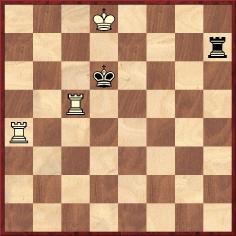
1 Rh5, and if 1...Rxh5 2 Ra6+ Kc5 3 Ra5+ ‘e con lo scacco di infilata il Bianco guadagna la Torre’.
(4324)
As reported in C.N. 74 (see Chess Jottings), page 94 of Chess by Paul Langfield (London, 1978) had the following in its Glossary:
‘Skewer: an attack on a piece which is beyond the piece occupying the square attacked.’
A similar indigestible wording was on page 54:
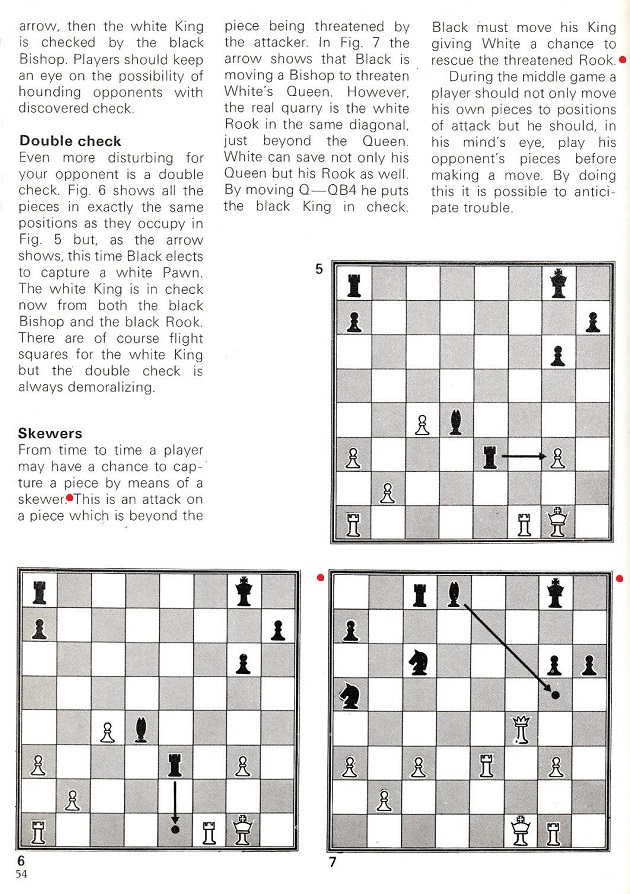
Those who have seen the book may be unsurprised by the suggestion that White can extricate himself from the skewer by playing his queen to a square defended by a black piece.
An additional alleged kind of skewer (‘when the attacking piece is between the two defenders’) was discussed by James Eade on pages 108-109 of Chess for Dummies (Hoboken, 2011):
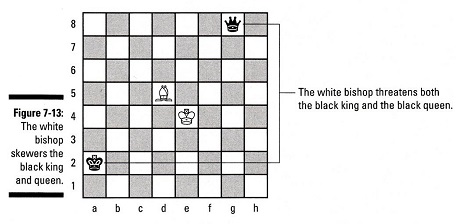
Most writers would call this a bishop fork.
Two definitions of ‘skewer’ from reference books:
Source: page 188 of Dictionary of Modern Chess by Byrne J. Horton (New York, 1959).
Source: page 261 of An illustrated Dictionary of Chess by Edward R. Brace (London, 1977).
Such definitions pass over the eventuality that the defender’s two pieces have the same value. On pages 37-38 of The Inner Game of Chess (New York, 1994) Andrew Soltis referred to the threat of the ‘Bd6 skewer’ after 36 Bf4 in Kasparov v Lutikov, Minsk, 1978:
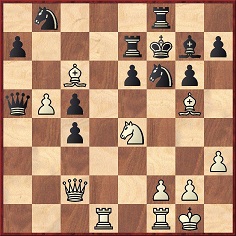
Soltis also quoted a remark of Kasparov’s about the position, naturally without giving the source, i.e. page 3 of The Test of Time (Oxford, 1986).
As regards the origin of the term ‘skewer’, we show the full text of an article referred to in C.N. 3061:
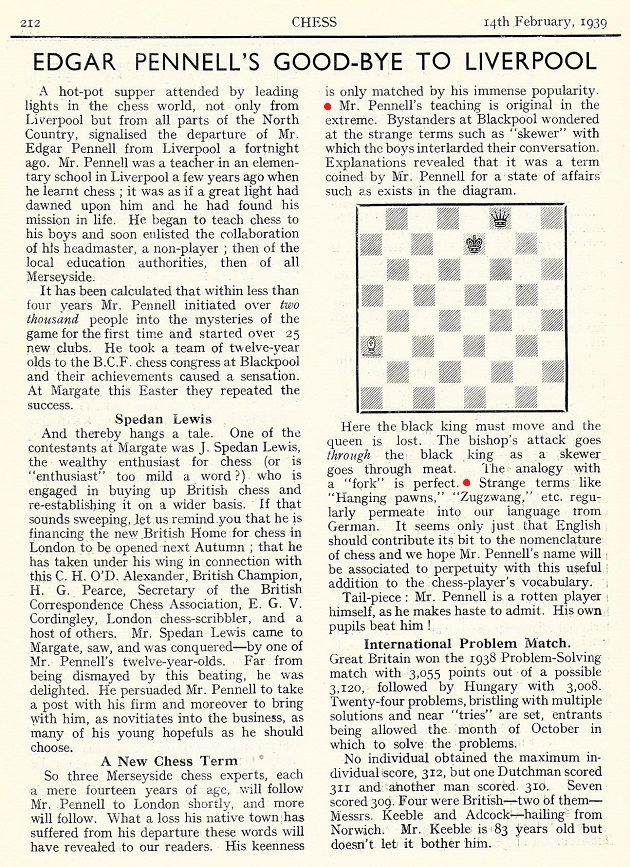
A photograph from page 275 of CHESS, 14 April 1937:
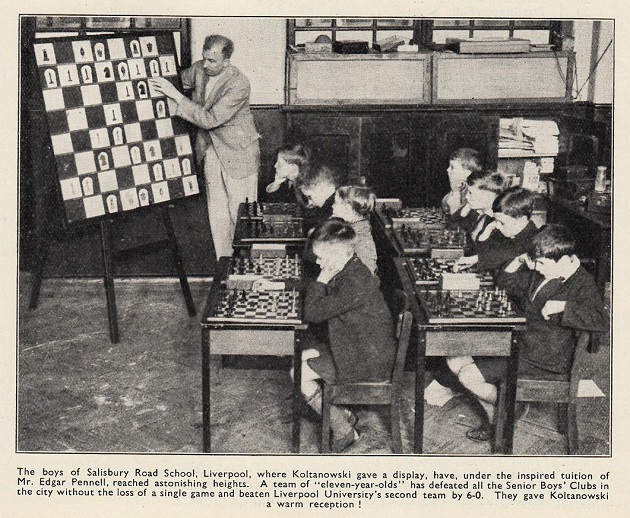
Below is a report about Edgar Pennell on page 7 of the Lancashire Evening Post, 6 July 1937:
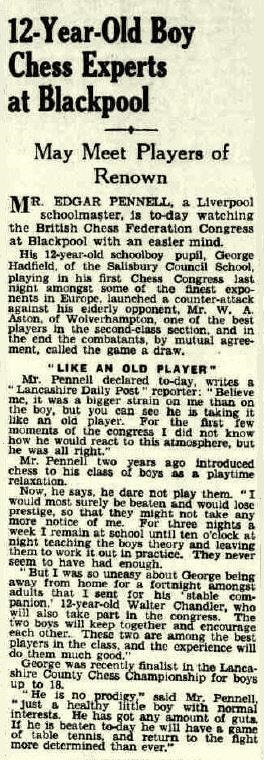
Further information about Pennell and George Hadfield was published on page 454 of CHESS, 14 August 1937.
On page 10 of The Times, 23 October 1976 Harry Golombek referred to Pennell’s contribution to chess in Liverpool:
‘There is the astonishing Edgar Pennell, himself (I hope he will forgive me) rather a weak player, but a wonderful teacher of the game and the originator of the great series of chess congresses for children in Liverpool where their numbers have risen to over 1,000 a year.’
Pennell was mentioned in the section on the skewer on pages 48-49 of Easy Guide to Chess by B.H. Wood (Sutton Coldfield, 1942):
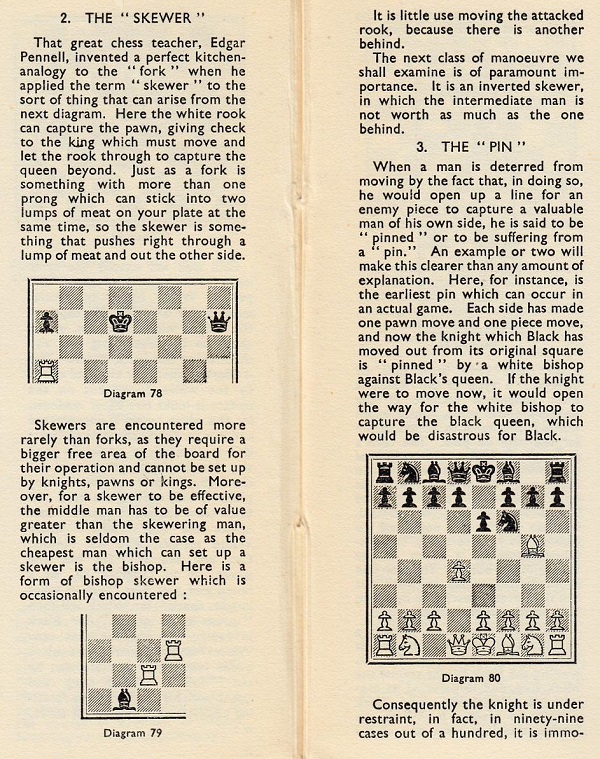
Wanted: further occurrences of the chess term ‘skewer’ before publication of Wood’s book, and particularly from the 1930s.
(8894)
Addition on 5 February 2025:
The above photograph of Edgar Pennell teaching chess had appeared on page 6 of the Liverpool Daily Post, 11 June 1936. There was a lengthier text and an extra photograph (George Hadfield v Walter Chandler) on page 3 of the weekly section of the Altoona Tribune, 17 October 1936, to name but one US newspaper on or around that date.
‘Skewer’ has no entry in the Oxford English Dictionary, as either a noun or a verb.
Recent C.N. items referring to Wikipedia are a reminder that its entry on the chess term skewer does not currently name the man who coined it, Edgar Pennell.
The photograph on page 275 of CHESS, 14 April 1937 (C.N. 8894) had already appeared widely in the press, in the United Kingdom and the United States. From page 6 of the Liverpool Daily Post, 16 June 1936:
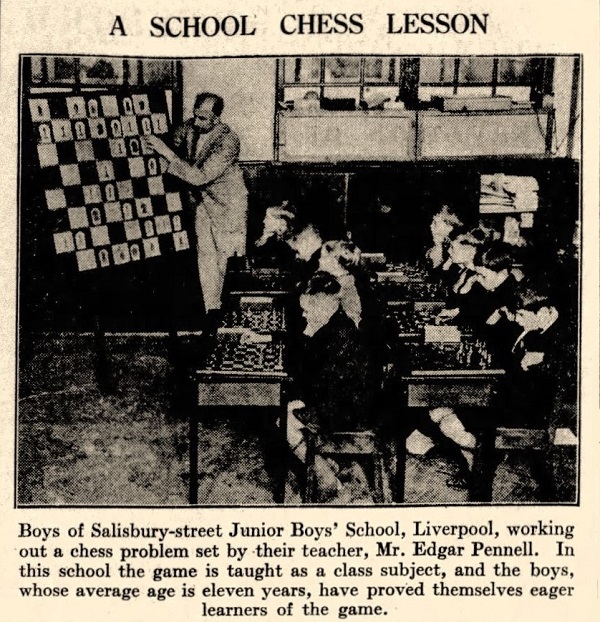
The originator (probably by 1937) of the chess word ‘skewer’ was shown in the Liverpool Daily Post, 30 January 1939, page 6:

Pennell’s name was seldom seen in chess literature, although page 153 of the May 1955 BCM reported that in Cheltenham on 19 March, during the National Chess Week, he had participated in a Chess Brains Trust, alongside C.H.O’D. Alexander, J.M. Aitken and J. Bronowski. The subjects included ‘Is chess a waste of time?’ and ‘Why are lady chessplayers outclassed by men, even in Russia?’.
From John Townsend (Wokingham, England):
‘An article in the Staffordshire Sentinel (31 January 1939, page 6) referred to Edgar Pennell as “a native of Bucknall”. This is Bucknall, Staffordshire, near Stoke-on-Trent. Since the birth of an Edgar Pennell was registered in the district of Stoke-on-Trent in the third quarter of 1902 (G.R.O., birth indexes, volume 6b, page 192), and the death of an Edgar Pennell was registered in 1985 in the district of Windsor and Maidenhead (death indexes, volume 19, page 68) which included the date of birth of 21 June 1902, there is no doubt that this is the skewer man.
Edgar Pennell’s birth certificate shows that he was born on 21 June 1902 at Eaves Lane, Bucknall; his parents were Ernest Pennell, a schoolmaster, and Bessie Ethel Pennell (formerly Mann). The birth was registered on 21 July 1902.
His marriage to Leah Bailey was registered during the first quarter of 1927 in the district of Liverpool (source: G.R.O. marriage indexes, volume 8b, page 234).
Edgar Pennell’s death was registered on 3 June 1985 in the district of Windsor and Maidenhead (volume 19, page 68). His death certificate shows that he died on 2 June 1985 at Upper Orchard, Mill Lane, Cookham, Berkshire. His date and place of birth were given as 21 June 1902 and Bucknell [sic], Staffordshire. He was a retired school teacher. The informant was named as Alwin Gilbert Allen, whose qualification was “Causing the body to be cremated”, and his usual address was The Bungalow, Odney Common, Cookham, Berkshire.
The cause of death was entered as:
“Myocardial Infarction
Coronary Atheroma
Certified by Julia Mercer MBBS.”His wife was a couple of years younger and died on 24 November 1992 at Sandpipers Residential Home, Worster Road, Cookham, Berkshire. Her will was proved at Winchester on 29 December 1992, the estate not exceeding £125,000.’
(12130)
To the Chess Notes main page.
To the Archives for other feature articles.
Copyright: Edward Winter. All rights reserved.